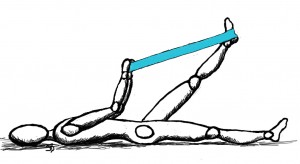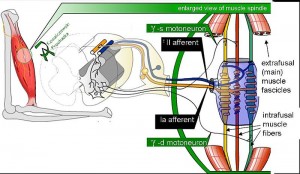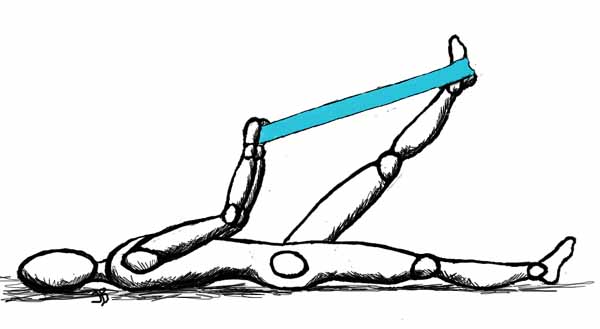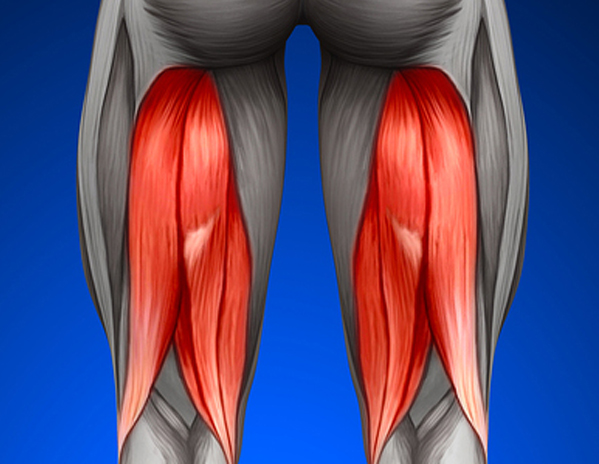Understanding Stretching – Passive Muscle Stretching – Part 2 of 4
Passive Stretching
So, we have established that muscles can get short if we hold them in short positions and short muscles can interfere with our flexibility and hasten our development of osteoarthritis, therefore it is desirable for us to stretch our short muscles. Stretching can go a long way into resolving the problems created by short muscles. What many do not know is that there is more than one type of stretching.
 Passive stretching is when we put a muscle in a posture that lengthens the muscle fibers while keeping the target muscle and the opposing muscle groups quiet. A great example of passive stretching is a typical hamstring stretch. There is probably no greater attention paid to a short muscle than our focus on our tight hamstrings. Many people spend a lot of time passively stretching their hamstrings and a common way to do this is to use a strap. The person will place the strap around their foot and then, either standing or lying on their back, will pull the strap with their arms until their leg is flexed forward. Another version of this passive stretch is when the person stands and places their foot on a bench or wall and flexes their body forward.
Passive stretching is when we put a muscle in a posture that lengthens the muscle fibers while keeping the target muscle and the opposing muscle groups quiet. A great example of passive stretching is a typical hamstring stretch. There is probably no greater attention paid to a short muscle than our focus on our tight hamstrings. Many people spend a lot of time passively stretching their hamstrings and a common way to do this is to use a strap. The person will place the strap around their foot and then, either standing or lying on their back, will pull the strap with their arms until their leg is flexed forward. Another version of this passive stretch is when the person stands and places their foot on a bench or wall and flexes their body forward.
The idea behind this is simple. We put the muscle in a longer position, it will re-adapt to this new position and then it will be longer. However, as simple as the process is, most people don’t realize how much muscle length is under the control of a very intricate system in the body. There is a very narrow margin in which passive stretching will actually lengthen a muscle before setting off a reaction in the nervous system which will, contrarily, shorten the muscle we are trying to stretch.
Stretch Receptors
 We have special proprioceptive nerve structures found within the muscles that constantly monitor the muscle length. When we put a muscle in a passive stretch, once that muscle lengthens beyond 10 to 20 percent of its starting normal posture, these proprioceptive nerves send a signal to our nervous system saying in effect: “Watch out! This muscle is about to be torn apart!”
We have special proprioceptive nerve structures found within the muscles that constantly monitor the muscle length. When we put a muscle in a passive stretch, once that muscle lengthens beyond 10 to 20 percent of its starting normal posture, these proprioceptive nerves send a signal to our nervous system saying in effect: “Watch out! This muscle is about to be torn apart!”
Now our bodies are quite brilliantly set up to prevent this kind of injury, so when the ‘watch out’ signal gets sent from the muscle length proprioceptive nerves, the body responds and that muscle begins to contract. The contraction is intended to stop the stretch and save the muscle from harm. What we feel when this begins to happen is that the stretch sensation in the muscle begins to increase. We feel the resistance to the stretch intensify. If we keep disregarding the automated response we will begin to feel pain in the muscle. At the point of pain we are actually doing damage to the muscle – at least on the microscopic level. At the point of pain we are ‘tearing the muscle apart’.
This disregard for our body’s natural protective process is one of the reasons that passive stretching can be so unrewarding to those who use it. Many people who passively stretch will unfortunately take the stretch to the very sensational or painful level. They try to force the stretch and end up shortening the muscle instead of lengthening it. They may even cause a muscle strain injury.
Passive Stretch Duration
However, there is another reason a passive stretch may not give lasting value. If we only lengthen our target muscle then we have only changed one part of why that muscle is shorter. A muscle is as long or as short as we habituate it to our frequent postures. If we lengthen a muscle that is a victim of our poor posture we have done nothing to change the lifestyle of that muscle because we have not changed the other muscles that interact with our target muscle.
For every joint in our body there are at least two different muscles that control its movement, often there are many more, such as in the shoulder joint, where there are 18 muscles that control it movements. Muscles that do the opposite action of one another are called opposing muscle groups. If you simply lengthen one muscle in the group, you have done nothing to adapt the other muscles to your target muscle’s change.
Let’s say we lengthened our hamstring with passive stretching and we did it well by making sure the sensation we created was mild. We held the stretch for over a minute to habituate the muscle to the new length. So far, so good. If we leave it like this though, the passive muscle stretch will not last. Since we only changed one muscle in the group, the rest of the muscles in that group will not act any differently. Specifically the opposing muscle group, in the case of the hamstring, this is the quadriceps group, does not take up the slack in the joint created in our now longer hamstring. The hamstring is loose, but the quadriceps group does not require it to stay loose. Soon, within about 45 minutes, the hamstring will go back to the shortness that it started with. If we don’t reinforce the new length, the new length will go away. If it is the habit of this muscle to be short, then it will go back to being short.
Coming up – Reinforcing Muscle Lengths to Keep the Hamstring Long – Part 3
Part 1
Part 4





